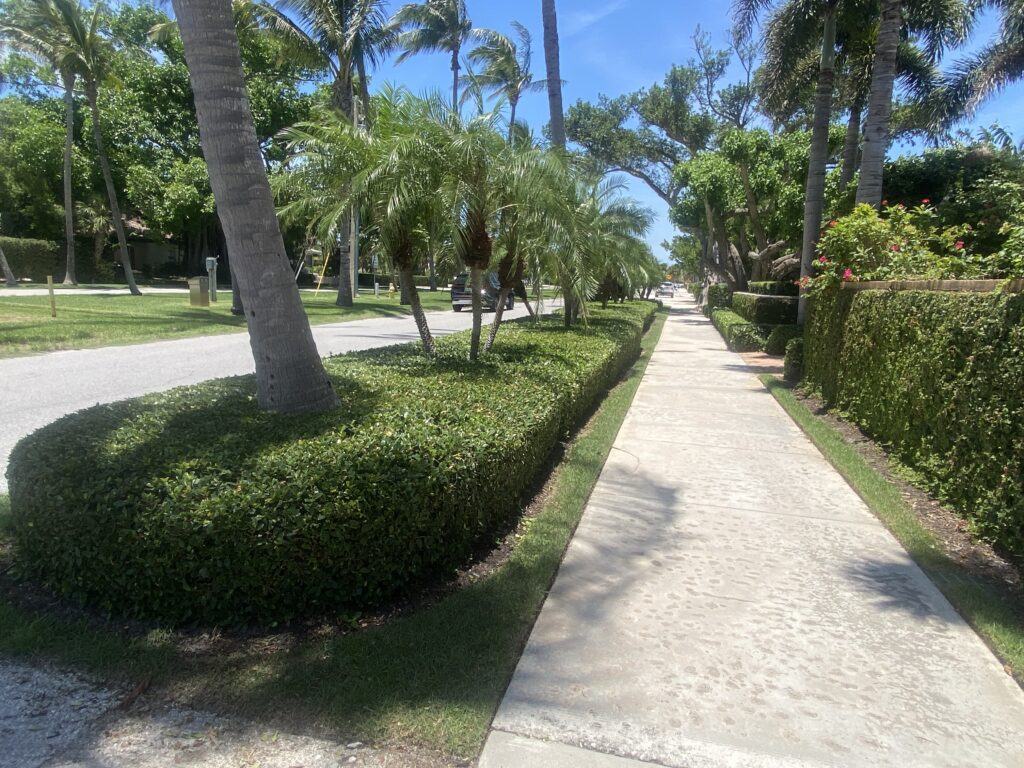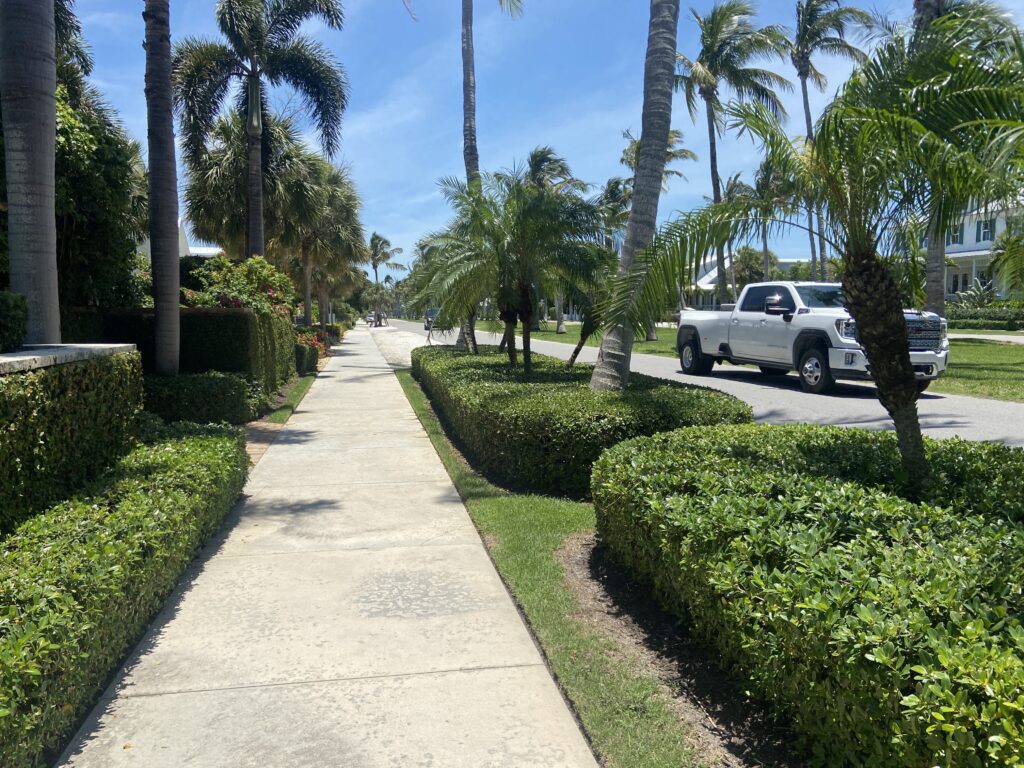Let’s start with parking by curbing the curb ‘lawns’

When people get worked up and annoyed about the issues of parking in Boca Grande, one concept that comes up, over and over again, is consistency in application. Fairness.
The emblem of this issue is the peculiar Boca Grande iteration, the curb lawn. The “curb lawn” is a fancy way of putting things in the public right of way to keep neighbors and visitors from parking near your house. But perhaps “curb lawn” is not a good phrase, as many of these “objets” are not lawns, but large, inelegant Flintstone-like boulders, or palms. Often this Bedrock installation art is done by an expensive landscape designer, other times it is just a few rocks dropped in from Murdock, palms sometimes drip irrigated by a sneaky hose from a nearby lawn.
In Chicago, there is a more equitable seasonal version of this practice. It is called “Chicago dibs” where one can, by habit, “claim” a parking spot that one has dug out of the snow. Each winter, residents put all manner of objects (lawn chairs, traffic cones, signs, even Barbie doll scenes) out in the spot. Google “Chicago dibs” and find all manner of Windy City exterior makeovers.
In terms of equity, police look the other way at Chicago dibs, which is technically illegal. There is no one trying to “take” a public parking space away from the township or neighbors, only a resident trying to preserve access to park, when they have shoveled their own car. Unlike our Boca Grande “dibs,” the parking space disappears, the snow melts away, and the spaces go back to the public realm. The police have better things to do, when neighbor Brian has got “dibs” on his spot until the snow melts.
For those of us who have lived in areas where you have to shovel a downtown street to park, it is irksome, at minimum, to have to dig out a parking space and then have someone take it. You have expended some muscle, even as you recognize that its not your street. Somehow, we all figure we have to get along.
These ‘Boca dibs’ incursions into parking, and public land, near downtown Boca Grande have grown through the years. Lee County has regulations regarding these incursions into the right of way. Some are permitted, others have been sort of surreptitiously added during the quiet season, and remain unchecked.



We asked Lee County, officially, what the rule was on these installations. Here is what Betsy Clayton, communications director, wrote us:
- To work within the Lee County right of way, you need to apply for a right of way permit and submit a plan for the work you would like to perform. Lee County’s right of way staff reviews the plan for approval.
- If “curb lawns” is referring to landscaping, we have allowed plantings that are frangible, which means they must be able to breakaway when/ if a vehicle hits them. They also may not exceed a 4-inch caliber at maturity, which means the base of the tree/vegetation must be less than four inches wide.
What is “frangible” on a right of way? Excellent question! This deserves a formal survey before there is any action on further reducing the number of parking places, or restricting the parking from 5th to 1st streets to only immediate neighbors, which we can assure you, has been discussed. In the Oct. 27, 2023 Boca Beacon, the issue was one of nine items mentioned in an email from Commissioner Kevin Ruane. The item was to “identify misuse or encroachment of private property onto Lee County right of way and implement steps to regain that parking.” Has this been completed?
Looking at permits at leegov.com for incursions into the right of way over the last decade, there have been few. Under the search term “Gilchrist Avenue” there are about a dozen, and some have involved only the replacement of grass. Addresses include 500, 121, 291, 361, 445, 350, 331, 290, 453 and 380 Gilchrist. Under the search term “Boca Grande” there are just over 125 requests, and most of them are not by residents, but by utility contractors, who take carefully the requirement that any digging in a public space must have a permit.
(This editor, in the interest of fairness, needs to lay out a personal bias. He attends St. Andrew’s. He has another former financial interest, as his in-laws lived next door to the church before they sold, in a family trust. They were, like this editor, during the last parking fiasco, on the “side” of some restrictions on parking on the median. But they desperately needed handicap parking in front, for a wheelchair. That parking is now landscaping.)
Between Lighthouse United and St. Andrew’s, there is landscaping that blocks any parallel parking. None. Zero. Zilch. The issue is galling for clergy, as visitors and residents for these cottages now park in front of the Episcopal and Methodist churches, taking up even more spaces from churchgoers, who we can assure you are not always able to walk long distances.
This is no small issue, as these churches have never had dedicated parking, and always parked on the street. For a century. 100 years! First Baptist was built in 1909, when William Henry Taft was president. That Taft, yes, the Taft who came after Theodore Roosevelt. The Ford Model T debuted the year before. This parking is not only grandfathered in, it is great-great-great grandfathered in.
At some point, we all have to share what is the public realm, and allow reasonable enjoyment for the churches. Since we are in the “church” arena here, and some may not get the point directly, let us give the reader a little mea culpa parable.
Before seat belts and iPhone games, many of us are old enough to remember a road trip “game” that we played as children, if only to irritate our parents and our siblings during family trips. The “game” involved personal space. One child would get on the “side” of another child. The distracted parent would look back, and say something to the effect of “please stay on your side of the seat.” Parent then would go back to talking to the other parent, and go back to navigating with the AAA Triptik map.
The older child, often, would then purposefully encroach on the “side” of the younger child, usually defined by some stripe, or the axle hump on the floor. In particularly long trips and through parental desperation, this might even involve a bit of electrical tape, a sort of Berlin Wall.
This sibling encroachment grew, first by extending a toe or finger, then a foot into the floor area of the other sibling, moving toward the center. Toys could be placed in common areas, to cause angst. This poking would continue, until the weaker party was stuck in the corner, or provoked into hitting back. At some point, the bullying party would pull their feet or hand back, well before the beleaguered parent turns around for a warning.
At a certain point, the parent puts down their Triple A map, and sorts out the bickering. And the family stops for ice cream, and talks about how they get to Yellowstone in peace.
Perhaps we all ought to go together on this parking “trip” and work it out?
Garland Pollard is the editor of the Boca Beacon. Email editor@bocabeacon.com.









